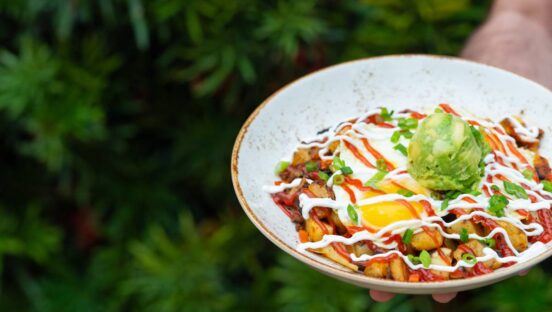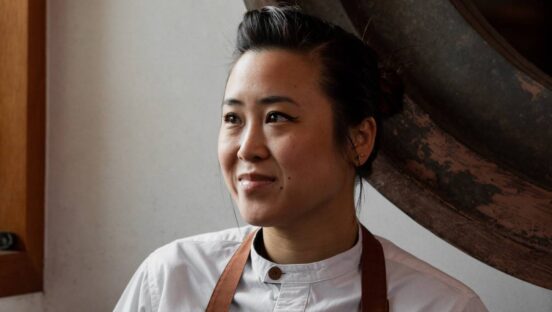






It might be time to retire the tag “new normal.” COVID-19 has splintered the restaurant landscape far too long to simplify challenges without a nod to the future. As much as things shifted in regards to consumer behavior and operator response, the pandemic is likely more an era than a “new normal,” so to speak. Restaurants and guests will overcome. Will some of the changes endure and disruptions recur? Are innovations born out of COVID here to stay? No question. But what you presently see is not an indefinite reality. Just as pre-COVID compared to, say, five years prior, was not a “new normal” then. Restaurants were adjusting while also preparing. It was yet another stage in a sector defined by its ability to reinvent itself. Look at casual dining in 2019 versus 2009. Did anybody predict “off-premises” would take precedence over deep discounting?
As people often say, if you want to take the pulse of the American consumer, look at restaurants. And it’s unfolding in real time, from contactless options to drive-thru-only prototypes to app proliferation to mobile at the center of the transaction journey.
Yet despite how compressed and rushed transformation felt over the past nine or so months, restaurants will morph again before 2021 is finished. Operators can’t afford to get static now, global crisis or not. So this “new normal” dynamic might best be called a (dramatic) juncture in evolution. One that changed the trajectory of dining for years, even decades. In many scenarios, it was an acceleration of trends already crashing the picture before, such as delivery. In others, restrictions and mandates backed operators against the wall and forced them to innovate outside the blueprint, with some solutions sticking long term.
Regardless, restaurants just weathered the most challenging and oddest year on record, and nothing is settled yet. This coming year promises to bear even more disruption and confront restaurants in ways no playbook ever prepared for. Winter is on the doorstep. A vaccine is reportedly on the horizon. States are reshutting dining rooms while others, like Florida, remain open in the face of case surges. Is federal aid in the cards? How will labor unfold in a world where going to work carries a personal safety risk? Is the dining room losing relevance for quick-serves? All of these questions weigh heavily as the calendar turns. And we haven’t even touched on technology yet.
From a list of industry experts, here’s what to consider as another game-changing year arrives.
Emil Davityan, co-founder and CEO of Bluedot, a company that provides location technology for mobile apps, believes restaurants in 2021 will emerge from a boot-strapped approach to one that enables efficient execution and well-crafted customer experiences as they battle for share. In other terms, from pivot to progress as restaurants get their digital infrastructure in order.
Some points:
The lines will blur between quick-service, fast-casual, and even some casual-dining concepts amid an ongoing shift toward off-premises consumption.
Dining outside the four walls eliminates the ability for restaurants to differentiate themselves through the in-store experience they provide, the company said. Instead, operators’ influence over the customer experience has been reduced to the quality of the food and the service they provide at the two main customer touchpoints—ordering/payment and pickup. Mobile ordering and pickup will become essential to providing a rewarding customer experience. A focus on the experience outside the restaurant will lead to a significant increase in investments in digital and mobile technologies that could be used to ease ordering, reward frequency, encourage store pickups, provide gamification, enhanced loyalty rewards programs, and more.
Bluedot adds the current landscape could present ramifications 5–10 years down the line.
As some play catchup, a handful of leaders will roll out advanced next-gen off-premises systems in 2021 that will set the standard for the next decade.
“Consumers have significantly increased their usage of the drive-thru amid the pandemic contributing to a 43 percent jump in just three months, according to Bluedot’s second State of What Feeds Us report [More on that here],” the company said. “Top brands will evolve their drive-thrus to include digital menu boards, geolocation, and more, and will also reinvest in improving the functionality of mobile apps as part of their efforts to better manage the customer experience.”
This same “cream-to-the-crop” notion, common during major periods of change, appeals to delivery, too. More operators will seek to regain ownership of their customers and end strained and profit-draining relationships with aggregator services in 2021, Bluedot said. Learning from the solutions they hastily deployed over the past several months, restaurant brands will become more closely identified with their own ability to provide seamless mobile and digital experiences for ordering, pickup and delivery, eliminating their reliance on third-party delivery services.
COVID pushed guests to mobile. There’s no denying that fact. Close to 90 percent (88) said they were suddenly using the channel more than before in Bluedot’s study. “Purchase history, omni-commerce and delivery, frequency and dwell time derived from mobile app usage will become pivotal to personalized service,” the company said. “It will also determine future relationships with natively digital generations: 2021 will be a year of rapid testing and deployment of solutions and technologies with a particular focus on mobile and data. In turn, large operators will roll out adapted solutions in markets where personalization is most needed.”
As a result, operators will seek more end-to-end, holistic solutions that integrate their disparate technologies this coming year. This will facilitate the management of the customer experience, no matter what channel customers choose to use, Bluedot said. In response, technology providers will verticalize or consolidate in order to provide the kinds of end-to-end solutions operators are seeking. Operators recognize the imperative of time to market and long-term technology roadmaps have condensed into a much shorter window as consumer behaviors continue to shift. Operators will also need to weigh the impact that the increasing investments in technology has on their franchisees. Corporate management must make these changes palatable to their operator partners, preferably through seamless, turnkey installations.
Another possibility is the evolution of curbside to carside. “Consumers will come to expect a fast, pleasant and hassle-free experience the moment their car pulls into a curbside space with automated check-in and orders brought directly to their car upon arrival,” Bluedot said. “Mobile technologies, including geolocation and predictive arrival technology, will alert stores when a customer is approaching and the moment they pull into a curbside space so staff can be ready upon arrival.”
NCR, a software- and services-led enterprise provider in the financial, retail, and hospitality industries, adopted a look-ahead approach. With some of the COVID shock behind restaurants, operators have begun to refocus priorities.
“The stark reality … is that sidewalk tables, back patios, and the use of off-premises ordering alone will not provide enough revenue to keep restaurants afloat for the long-run,” NCR said of some of today’s COVID lifelines, like makeshift drive thrus. “Restaurants rely on seamless dine-in service to create meaningful relationships with guests that drive revenue, referrals, and repeat service.”
This suggests 2021 will see more and more operators make the change to “contactless” or “touchless” operations. Restaurants will minimize the number of shared surfaces and objects and shift to digital ordering. “A contactless payment strategy, for example, allows customers to pay without handing their card over … These types of payments also have the added benefit of being faster and more secure compared to traditional methods,” NCR said.
The QR comeback. Alongside contactless options, QR codes have taken on fresh prominence. Even high-end Ruth’s Chris deployed the tech so guests could pull up menus on mobile devices. Fast casual Newk’s set its model up as a “hardware-less kiosk,” or web app that enabled users to order and pay using their own devices once they walk in the restaurant. No lines, no queues. Stand in the corner and wait, if that’s your desire. After paying with Google Pay, Apple Pay, or a credit card (a gift card function is coming) staff bring the food out to wherever they decided to wait.
“This limits the amount of physical interactions in the ordering and payment experience, while increasing table turns and allowing staff to focus on delivering a safe and enjoyable dining,” NCR said.
“Consider also: Research Mastercard published in April of this year demonstrated nearly eight in 10 consumers say they use contactless payments,” the company added. “Eighty-two percent of consumers feel it is a cleaner way to pay. Factor in the convenience element and 74 percent of consumers say they will continue to use contactless well into 2021.”
Driving brand loyalty through digital channels. Restaurants have reported throughout COVID a shift in the loyalty dynamic. Pre-virus, it was one of the most fleeting truths of younger consumers. Now, however, brands have a chance to earn long-lasting customers across a variety of factors—from seamless dining to safety measures to quality food. “[Customers] expect digital ordering options, on-demand choices and services that cater to their online lifestyle. Not to mention an increased level of personalization when served with advertising and promotions,” NCR said.
Digital channels were on the upswing before COVID. But Incisiv recently released a report that predicted digital sales will comprise 54 percent of limited-service business within the next five years. What’s staggering about that is it’s a 70 percent increase over pre-virus projections.
NCR said one operator reported 70–80 percent of orders arrived via its mobile app during COVID—an increase of more than 20 percent. The company already boasted a strong, growing digital presence and was equipped for digital ordering, carryout, drive-thru, and delivery. It had also installed pick-up shelves enabling customers and delivery drivers to get their orders contact-free.
“Chains such as this understand their digital and physical presences are not mutually exclusive. The two must work interchangeably to provide guests with a seamless, omni-channel experience that creates ‘sticky’ relationships for the long-run,” NCR said.
“The coming year will bring its own set of unique challenges and difficulties—cold weather and the coming flu season will likely have an outsized impact on not only restaurants, but banks, stores and other businesses as well,” added Dirk Izzo, president and general manager of NCR Hospitality. “Even with the possibility of a vaccine on the horizon, operators can take steps now to secure future success by transitioning to digital, contactless technologies that create seamless, engaging guest experiences, pandemic or no pandemic.”
Dan Sines, CEO of Traitify, a personality assessment data company, circled three topics.
Automation:
“Due to the pandemic, HR teams have experienced a variety of challenges, including handling company layoffs and furloughs, all while coping with their own teams being reduced. For HR teams to drive recovery and cope with a sudden surge of applicants they must automate the various stages of the talent acquisition and employee engagement process. Our industry has seen significant developments in automation over the last few years, but 2021 will be the year every HR team will streamline at least one major process—screening, assessment, onboarding—through software automation.”
HR teams:
“Before the pandemic, the labor market was quite shallow, forcing many businesses to hire candidates who may not have been the perfect fit for their open positions. As certain industries continue to feel the impact of the pandemic, companies will either have a more competitive set of candidates to choose from or need to find the right fit candidate to retain employees through recovery. Hiring now and into 2021, HR teams will need to find solutions that can help them manage and sort out quality candidates for each position, seeking out those who have the ability to learn, change and adjust.”
Hospitality:
“The unfortunate reality is that hospitality will suffer the pandemic’s effects longer than any other industry. Organizations will be left with large swaths of empty space and will need to find creative ways to use their space and people to generate revenue. Working with other industries [e.g. logistics companies for delivery staging] will be critical to preventing further folding of locations. Given that additional pressure into 2021, hiring quality employees to fill out a depleted hotel workforce is crucial as hiring will be sparse for these companies.”
Richard Jones, CMO of Cheetah Digital, a company that works with Bloomin’ Brands and &pizza, among others, spoke on three more.
The traditional concept of “Offer Management” turned on its head in 2021:
“Marketers want to deliver better and more relevant content to their customers to increase marketing effectiveness. In order to deliver this, the traditional concept of ‘offer management’ needs to be turned on its head. In today’s day and age, offers can be messages, images, content, programs, coupons, ‘thank you’ messages and various other key customer engagement mechanisms that are deployed in real-time. It’s all about enabling the value exchange with your customers. The key enabler to this is intelligence, and letting the machine do the heavy lifting of content and offer optimization and letting marketers focus on what they do well, driving strategy and fostering creativity.”
Surge In loyalty marketing In 2021, but with a twist:
“In times of recession, it is always easier to focus on getting more revenue from existing customers than trying to buy new ones. This puts the focus on marketers to invest in loyalty programs to optimize customer lifetime value. Original research from eConsultancy sponsored by Cheetah Digital showed already by March as the COVID pandemic started to hit that 9X as many Americans were looking to increase their participation in loyalty programs than decrease involvement. But increasingly marketers will construct true loyalty strategies versus reward programs, where advocacy and engagement is as important as points for purchases. In 2021, marketers will use loyalty strategies to optimize customer lifetime value in a tough economic environment.”
The reinvention of personalization:
“Gartner notes that 27 percent of marketers believe data is the key obstacle to personalization, revealing their weaknesses in data collection, integration, and protection. Personalization is all about the data; batch, streaming, structure or unstructured, you need it in one place to aggregate, analyze, and activate. Personalization as a strategy, personalization as a technology, and personalization as a Market is ripe for reinvention. As Seth Godin noted in the opening keynote of Signals20, it’s not as much about Personalization as it’s about being “Personal”. The next generation of personalization is not about cookies or 3rd party data, it’s not about merchandising, and it’s not about guesswork. The next generation of personalization is about relying on deep data insights, first and zero-party data and using machine learning to derive not only the right content, not only the right offer, not only the right channel, but the right sequence of events that leads to an automated path to conversion. The next generation of personalization is about providing a value exchange for consumers in the “moment” when you have them on your mobile app, on your site, in your store, how can you provide them something that will generate trust and affinity with the brand?”
Kimpton Hotels & Restaurants annually unveils its Culinary & Cocktail Trend Forecast. This year’s edition refreshed with a look back at how COVID impacted F&B trends and how evolving consumer behavior will shape 2021. “We know that diners’ needs have changed—the COVID-19 pandemic has brought out the foodie or at-home chef in many of us,” said Scott Gingerich, Kimpton’s SVP of restaurants and bars. “While diners first leaned into comfort and nostalgia, heading into the new year we’re seeing a return to health and wellness-inspired culinary and cocktail creations.”
Takeaways from 2020:
Treat Yourself: Restaurant Edition. While consumers cooked more than ever before this year, they missed more elevated or complex meals. This led to a surge in restaurant orders of dishes guests couldn’t execute as easily at home at Kimpton’s 75-plus spots—including prime rib, roast duck, freshly shucked oysters and paella.
“Home-Cooked” Takeout. Kimpton witnessed a rise in demand for do-it-yourself restaurant-quality food that can be easily prepared or heated up with simple instructions at home. Consumers ordered ready-to-heat soups, taco kits and sandwiches and to-go cocktails where they simply combine the ingredients, add ice and garnish.
Comfort Me Please: Rise in Nostalgic Comfort Food. The most popular room service orders included burgers, pizza, grilled cheese and pasta. The data showed that salads saw one of the sharpest declines in food items purchased from March to September across all restaurants. For instance, at Kimpton Vividora Hotel in Barcelona, cheesecake was a surprising hit this year, and at the Kimpton Clocktower Hotel in Manchester, England, F&B leaders saw a spike in demand for burgers and grilled cheese.
Thinking ahead to 2021:
Is Carob a Carb? Comfort Food Will Fade Out & Health Food Will Reign Supreme—Again. Over the last several weeks, Kimpton said it has already seen a shift away from comfort food toward healthy dishes with fresher ingredients and even more vegan and vegetarian options. (And just wait until January, when New Year’s resolutions join the picture). Expect healthy, hearty bowls using grains like bulgur or farro, with roasted vegetables and mushrooms and punchy, herbal dressings. Freeze dried fruits and veggies will also see a surge in popularity. Lastly, expect carob to make a comeback–the plant-based, low sugar, antioxidant-rich ingredient is fantastic as a natural sweetener.
Garden Pesto & Edible Cactus Will Be the New Banana Bread. Home gardens are all the rage, with people adding fresh herbs, citrus, chilies and veggies to all their dishes. The next iteration of this is homemade oat milk, pesto, jam, and pickled everything, Kimpton said. Burgeoning home chefs are dehydrating, canning, fermenting and pickling more than ever before. People are also starting to grow and eat some cacti species, adding unique flavors and health benefits to an array of dishes. Grilled cactus can be part of a flavorful fajita dish or elevate a tossed salad with unexpected texture in each bite.
Local is the New Sustainable. There is a growing sense of community and support for local businesses and suppliers, and the desire to band together and help local communities push through these difficult times. People will also prefer locally sourced foods that represent the area of the restaurant. As an example, King Tide Fish & Shell at Kimpton RiverPlace Hotel in Portland recently partnered with the chef of nearby Olympia Oyster Bar to create a “Cockteles y Mariscos” six course pairing menu of cocktails and fresh seafood-based dishes.
The experience, what Kimpton saw in 2021:
More Outdoor Dining Options. Safer, socially distant outdoor dining is unsurprisingly in demand, leading to restaurateurs investing in new outdoor spaces, layouts and creative experiences. These new or enhanced spaces have created the closest thing to a pre-pandemic dining experience that most people have missed while in quarantine.
Streamlined Menus. To minimize food waste and simplify things for restaurants, Kimpton saw tighter and smaller menus, with an emphasis on verbal daily specials to help expand menus when needed.
Let’s Keep This Private … Dining and Drinking. While banquet dining and business-driven group dinners decreased, private dining soared with a large increase seen YOY as consumers were looking for COVID-friendly isolated dining. At Kimpton Maa Lai Bangkok, hotel management saw success with masked bartenders making Daiquiris, Old Fashioneds and Manhattans for guests in the safety and privacy of their own room.
And next year?
Winter is Coming and So Are Creative Dining Options to Suit Any Climate. Restaurateurs will continue adding new outdoor dining experiences, even in markets with cold weather. Expect to see every outdoor space reimagined to create unique experiences for guests (say hello to snow globe dining). Kimpton Clocktower Hotel in Manchester is also creating a Winter Garden for guests to enjoy brunch, afternoon tea and cocktails in a winter wonderland. Kimpton Maa Lai Bangkok is offering Cycle & Picnic packages so guests can enjoy the outdoors while eating an elevated and tasty meal.
More Intimate, Highly Personalized Event Spaces. From an events perspective, guests are looking for intimate, highly personalized experiences in spaces that are comfortable, warm and have an inviting atmosphere. Outdoor micro-weddings have been popular at the Kimpton Hotel Monaco Philadelphia, with personalized, next-level details like a Smoked Out Old-Fashioned Station, customized face masks for every guest and sunset helicopter rides for the newlyweds.
Ambiance Matters More Than Ever. Going out is more of a treat than ever before and as a result, consumers will see more tented, heated rooftop spaces, leveraging high quality sound systems and playlists to create that perfect atmosphere for guests. Restaurateurs and bar owners will go all in on lighting, greenery, landscaping, heating and cooling and amazing framed in views. Kimpton Journeyman Hotel in Milwaukee offers spaced out rooftop dining and drinking with picture perfect views of the city.
Like food and dine-in business, the beverage game changed in 2020. Bars were hit perhaps even harder than restaurants. So what can we expect? Let’s start with what we saw.
In 2020:
Pour Me a Strong One. Single servings of agave and mezcal were one of three—alongside sparkling wine and Riesling—beverages that saw a big spike in orders, Kimpton said. They also observed a rise in elevated cocktails on-property, as many guests weren’t as comfortable making these at home. It’s no surprise that to-go and large format cocktails have also been more popular than ever for takeout. Additionally, the category of “happy hour” (enjoyed outdoors, in-room or to-go) in Kimpton data saw a 17 percent increase year over year, indicating that consumers are looking for more economical options in this challenging economic climate.
Making a Sour Year Sweeter. Bottles of Riesling and sparkling wine both saw increases in purchases, which are two of only seven offerings across all categories that experienced year-over-year increases. Riesling saw the largest beverage growth, across both alcoholic and non-alcoholic, with a 32 percent increase.
Drinks Education is a Hit. Wine and cocktail education was a huge trend in 2020, with virtual cooking, cocktail making and wine tasting sessions gaining popularity for people during quarantine. This trend, which was adopted by Kimpton via Virtual Social Hours, gave bartenders and sommeliers a chance to connect with consumers directly, sharing the stories behind the wines and drinks they create.
For next year:
Mocktails + Cleaner Cocktails. Consumers will be looking for fresher, “healthier” cocktails in 2021. Expect to see a demand for dual-purpose mocktails and cocktails with lower ABV with ingredients like honey, ginger, green tea, lemon, vegetables and herbs. Hard kombucha, spiked seltzers and CBD in drinks, boozy coffee, natural wines and lower calorie wines are also here to stay.
Goodbye Vodka Sodas—Bring on the Elaborate Cocktails. Because it’s all about balance, consumers will still treat themselves when they want to indulge! Fewer drinking occasions means imbibers will be more likely to try a memorable concoction. Many will prefer cocktails with premium spirits that incorporate more unusual or uncommon ingredients. For example, at Kimpton Shinjuku Tokyo, people are getting cocktail curious with ingredients like lamb fat infused gin and dried mushrooms.
All-Encompassing “Drinks Sommelier.” Kimpton experts predicted the evolution of the sommelier as someone that is a master of more than just wine. A “Drinks Sommelier” will be an expert that guides diners through the nuances of premium rum, whiskey, and tequila, in addition to wines, beers and sake. These sipping spirits have piqued the interest of cocktail lovers for their diversity, character and complex flavors.
Wanderlust-Inspired Wines. Due to the newfound knowledge from wine education courses during quarantine, consumers are looking for diversity in their wines and products. Kimpton predicts wines from new regions will emerge from places travelers dreamed of going in 2020 including Moldova, Croatia, Hungary, Morocco, Lebanon, South Africa and even Mexico. People are more open minded about trying new regions and producers.












